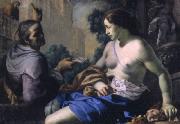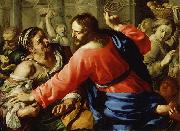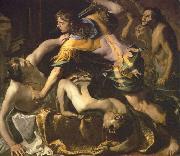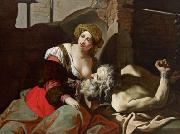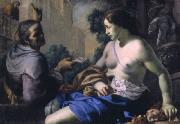Bernardino Mei Huiler la Reproduction de TableauAll Bernardino Mei Oil Paintings(1612/15 - 1676) worked in a Baroque manner in his native Siena and in Rome, finding patronage above all in the Chigi family. Briefly a pupil of the Sienese draughtsman and cartographer Giuliano Periccioli, where he learned the art of engraving, Bernardino passed to the studio of the painter Rutilio Manetti and probably also served in the workshop of Francesco Rustici. He painted in and around Siena, where his work came to the attention of Cardinal Fabio Chigi, who, once elected pope as Alexander VII (1655), called Bernardino Mei to Rome in 1657. There Bernardino came under the influences of Mattia Preti, Andrea Sacchi and Pier Francesco Mola, and of Guercino, to the extent that until the 20th century Bernardino's fresco of Aurora in Palazzo Bianchi Bandinelli was attributed to Guercino himself. Through the fast friendship that bonded him to Gian Lorenzo Bernini, whose studio he frequented, he applied that sculptor's sense of theatrical action to his own mythological and allegorical subjects. He died in Rome in 1676. |
|||

|
|||
|
|
|||
|
||||||||||||
| Bernardino Mei (1612/15 - 1676) worked in a Baroque manner in his native Siena and in Rome, finding patronage above all in the Chigi family. Briefly a pupil of the Sienese draughtsman and cartographer Giuliano Periccioli, where he learned the art of engraving, Bernardino passed to the studio of the painter Rutilio Manetti and probably also served in the workshop of Francesco Rustici. He painted in and around Siena, where his work came to the attention of Cardinal Fabio Chigi, who, once elected pope as Alexander VII (1655), called Bernardino Mei to Rome in 1657. There Bernardino came under the influences of Mattia Preti, Andrea Sacchi and Pier Francesco Mola, and of Guercino, to the extent that until the 20th century Bernardino's fresco of Aurora in Palazzo Bianchi Bandinelli was attributed to Guercino himself. Through the fast friendship that bonded him to Gian Lorenzo Bernini, whose studio he frequented, he applied that sculptor's sense of theatrical action to his own mythological and allegorical subjects. He died in Rome in 1676. |
||||||||||||
|
|
||||||||||||
| ID de tableau:: 71352 David and Bathsheba David and Bathsheba 17th century Oil on canvas 17th century Oil on canvas |
||||||||||||
|
|
||||||||||||
| ID de tableau:: 71353 Christ Cleansing the Temple Christ Cleansing the Temple c. 1655 Oil on canvas 41 x 55 1/2 in. c. 1655 Oil on canvas 41 x 55 1/2 in. |
||||||||||||
|
|
||||||||||||
| ID de tableau:: 71355 Orestes slaying Aegisthus and Clytemnestra Orestes slaying Aegisthus and Clytemnestra Orestes slaying Aegisthus and Clytemnestra 1654(1654) Orestes slaying Aegisthus and Clytemnestra 1654(1654) |
||||||||||||
|
|
||||||||||||
| ID de tableau:: 71539 Caritas romana Caritas romana 17th century Oil on canvas 98 x 131 cm 17th century Oil on canvas 98 x 131 cm |
||||||||||||
|
|
||||||||||||
| ID de tableau:: 72452 David and Bathsheba David and Bathsheba Date 17th century Medium Oil on canvas Dimensions ? cm cyf Date 17th century Medium Oil on canvas Dimensions ? cm cyf |
||||||||||||
|
|
||||||||||||
| Artiste précédent Artiste prochain | ||||||||||||
|
|
||||||||||||
|
Bernardino Mei (1612/15 - 1676) worked in a Baroque manner in his native Siena and in Rome, finding patronage above all in the Chigi family. Briefly a pupil of the Sienese draughtsman and cartographer Giuliano Periccioli, where he learned the art of engraving, Bernardino passed to the studio of the painter Rutilio Manetti and probably also served in the workshop of Francesco Rustici. He painted in and around Siena, where his work came to the attention of Cardinal Fabio Chigi, who, once elected pope as Alexander VII (1655), called Bernardino Mei to Rome in 1657. There Bernardino came under the influences of Mattia Preti, Andrea Sacchi and Pier Francesco Mola, and of Guercino, to the extent that until the 20th century Bernardino's fresco of Aurora in Palazzo Bianchi Bandinelli was attributed to Guercino himself. Through the fast friendship that bonded him to Gian Lorenzo Bernini, whose studio he frequented, he applied that sculptor's sense of theatrical action to his own mythological and allegorical subjects. He died in Rome in 1676. |
||||||||||||
|
|
||||||||||||
|
CONTACTER DES Etats-Unis |





